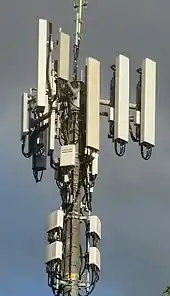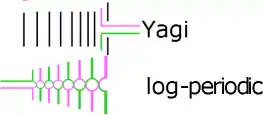Passive radiator
In a radio antenna, a passive radiator or parasitic element is a conductive element, typically a metal rod, which is not electrically connected to anything else.[1] Multielement antennas such as the Yagi-Uda antenna typically consist of a "driven element" which is connected to the radio receiver or transmitter through a feed line, and parasitic elements, which are not. The purpose of the parasitic elements is to modify the radiation pattern of the radio waves emitted by the driven element, directing them in a beam in one direction, increasing the antenna's directivity (gain). A parasitic element does this by acting as a passive resonator, something like a guitar's sound box, absorbing the radio waves from the nearby driven element and re-radiating them again with a different phase. The waves from the different antenna elements interfere, strengthening the antenna's radiation in the desired direction, and cancelling out the waves in undesired directions.

| Part of a series on |
| Antennas |
|---|
 |
Description
The parasitic elements in a Yagi antenna are mounted parallel to the driven element, with all the elements usually in a line perpendicular to the direction of radiation of the antenna. What effect a parasitic element has on the radiation pattern depends both on its separation from the next element, and on its length. The driven element of the antenna is usually a half-wave dipole, its length half a wavelength of the radio waves used. The parasitic elements are of two types. A "reflector" is slightly longer (around 5%) than a half-wavelength. It serves to reflect the radio waves in the opposite direction. A "director" is slightly shorter than a half-wavelength; it serves to increase the radiation in a given direction. A Yagi antenna may have a reflector on one side of the driven element, and one or more directors on the other side. If all the elements are in a plane, usually only one reflector is used, because additional ones give little improvement in gain, but sometimes additional reflectors are mounted above and below the plane of the antenna on a vertical bracket at the end.

All the elements are usually mounted on a metal beam or bracket along the antenna's central axis. Although sometimes the parasitic elements are insulated from the supporting beam, often they are clamped or welded directly to it, electrically connected to it. This doesn't affect their functioning, because the RF voltage distribution along the element is maximum at the ends and goes to zero (has a node) at the midpoint where the grounded beam is attached.
The addition of parasitic elements gives a diminishing improvement in the antenna's gain.[2] Adding a reflector to a dipole, to make a 2-element Yagi, increases the gain by about 5 dB over the dipole. Adding a director to this, to give a 3-element Yagi, gives a gain of about 7 dB over a dipole. As a rule of thumb, each additional parasitic element beyond this adds about 1 dB of gain.[2]
In an example of a parasitic element that is not rod-shaped, a parasitic microstrip patch antenna is sometimes mounted above another driven patch antenna. This antenna combination resonates at a slightly lower frequency than the original element. However, the main effect is to greatly increase the impedance bandwidth of the antenna. In some cases the bandwidth can be increased by a factor of 10.

Not all types of thin conductor multielement antennas have parasitic elements. The log periodic antenna is similar in appearance to a Yagi, but all of its elements are driven elements, connected to the transmitter or receiver.
References
- Poole, Ian (2010). "The Yagi Antenna". Radio-Electronics.com website. Adrio Communications, Ltd. Retrieved 2011-03-29.
- Poole, Ian (2003). Newnes guide to radio and communications technology. Elsevier. pp. 191–103. ISBN 0-7506-5612-3.